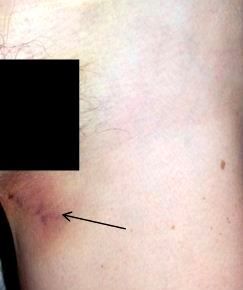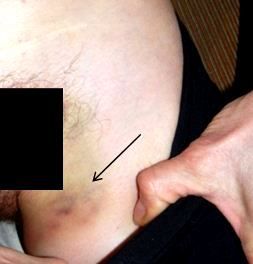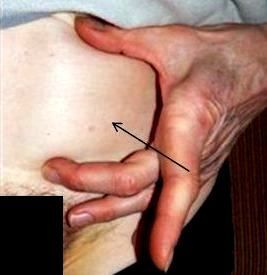- Clinical Technology
- Adult Immunization
- Hepatology
- Pediatric Immunization
- Screening
- Psychiatry
- Allergy
- Women's Health
- Cardiology
- Pediatrics
- Dermatology
- Endocrinology
- Pain Management
- Gastroenterology
- Infectious Disease
- Obesity Medicine
- Rheumatology
- Nephrology
- Neurology
- Pulmonology
Rectus Sheath Rupture With Hematoma Formation
The authors present a case of rupture of the rectus abdominis muscle with subsequent rectus sheath hematoma-an uncommon and often misdiagnosed cause of acute abdominal pain.

Figure 1.
Day 3: Mild ecchymosis
Acute left lower quadrant abdominal pain developed in a previously healthy, postmenopausal, 52-year-old woman on the second day of a lower respiratory tract infection associated with severe coughing. Her past medical history was significant for stage 1 hypertension and cough-variant asthma. Her past surgical history included 2 cesarean sections. Her medications consisted of lisinopril/hydrochlorothiazide, 20/25 mg/d, and fluticasone propionate/salmeterol inhalation powder, 250/50 µg twice daily. Penicillin was her only known drug allergy.
On the third day of the patient’s bronchitis, she noted a small ecchymosis in her left groin (Figure 1) and continued sharp pain in the left lower quadrant. She denied dizziness, fever, nausea, vomiting, diarrhea, or any genitourinary or gynecologic symptoms.
Five days later, the patient noted increased ecchymosis in the left inguinal region (Figure 2) and a distinct bulge in the area of initial pain (Figure 3). At this time, she presented to her primary care physician.


Figure 2.
Day 8: Increased ecchymosis
Figure 3.
Day 8: Left lower quadrant abdominal bulge
On physical examination, the patient was afebrile and her vital signs were stable. Cardiorespiratory findings were normal. There was tenderness in the left lower quadrant that corresponded with the 4 x 4-cm bulge that was evident only with forward flexion. Ecchymosis in the left inguinal region was noted.
A CT scan and complete blood cell count were ordered, but the patient refused them because she had no medical insurance. Conservative measures-rest, local heating pad application, and acetaminophen-were continued. The patient’s condition improved over the following week, and the bulge and ecchymosis likewise resolved completely.
The diagnosis was rupture of the rectus abdominis muscle with subsequent rectus sheath hematoma (RSH)-an uncommon and often misdiagnosed cause of acute abdominal pain. The associated ecchymosis is caused by sudden forceful contraction of the rectus abdominis muscle that produces acute shearing forces and results in vascular injury to the superior or inferior epigastric arteries. The resultant hemorrhage into the rectus sheath then dissects inferiorly into the space of Retzius and the anterior thigh.
Patients typically present with acute abdominal pain, an abdominal wall mass, or both. Pain may worsen when the muscles of the abdominal wall are tensed by lifting the head and shoulders or lifting both legs with bent knees (a positive Carnett sign).1
Factors that most frequently predispose to RSH are trauma, anticoagulants, hematologic disorders, cough, and pregnancy. In a 2010 retrospective study, 11 of 15 reported cases of spontaneous RSH were associated with some form of anticoagulation therapy, which patients were taking for atrial fibrillation or a mechanical valve replacement.2 The risk of anticoagulation-related hemorrhage varies with an individual patient’s comorbidities and the dosage and duration of therapy, which is subject to monitoring according to the accepted standards of care for the underlying condition.
Women are affected more frequently than men (ratio, 2 to 4:1); the disorder presents most frequently in the 5th decade of life. RSH is more common on the right side and in the lower quadrants because of the absence of the posterior layer of the rectus sheath below the arcuate line.3
The differential diagnosis may include appendicitis, acute abdomen, an enlarged urinary bladder, splenic enlargement, ovarian cysts or torsion, diverticulitis, abruptio placenta, septic shock, and myocardial infarction.1 The exact location of abdominal pain and the degree of hemodynamic compromise are key factors in determining the differential. The classic history of a sudden exertional force causing a marked contraction of the rectus abdominis muscle, along with the physical examination findings of ecchymosis and abdominal mass, can inform the trained eye to correctly identify RSH.
CT is considered the gold standard for making the diagnosis of RSH (100% sensitivity and specificity). However, ultrasonography is used frequently in the emergent care setting (70% to 90% sensitivity). MRI may be of use in cases where it is difficult to distinguish between a long-standing hematoma and a soft tissue tumor.1,2 In a 1996 case series, Bern and colleagues4 outlined a graded scale of diagnostic guidelines for RSH based on CT findings in 13 cases. The scale currently is not used widely in US hospitals.
Treatment
Treatment for patients with RSH most often is limited to conservative measures; analgesia is used in hemodynamically stable cases. Care should be taken to correct any predisposing coagulopathies in patients who are receiving anticoagulant therapy. Surgical intervention to control bleeding may be indicated in hemodynamically unstable patients. Death resulting from RSH is rare; it is most common in older patients who have multiple comorbid conditions.1-3
Clinical Pearl
With the increased use of anticoagulation therapy, especially in the older patient population, rectus sheath hematoma should be suspected in cases of sudden onset of acute abdominal pain with subsequent ecchymosis.
References
1. Fitzgerald JE, Fitzgerald LA, Anderson FE, Acheson AG. The changing nature of rectus sheath haematoma: case series and literature review. Int J Surg. 2009;7:150-154.
2. Carkman S, Ozben V, Zengin K, et al. Spontaneous rectus sheath hematoma: an analysis of 15 cases. Ulus Travma Acil Cerrahi Derg. 2010;16:532-536.
3. Mantelas M, Katsiki N, Antonitsis P, et al. Rectus sheath hematoma: a simplified emergency surgical approach. Open Cardiovasc Med J. 2011;5:4-5.
4. Bern-Serna JD, Snchez-Garre J, Madrigal M, et al. Rectus sheath hematoma: diagnostic classification by CT. Abdominal Imaging. 1996;21:62-54.
